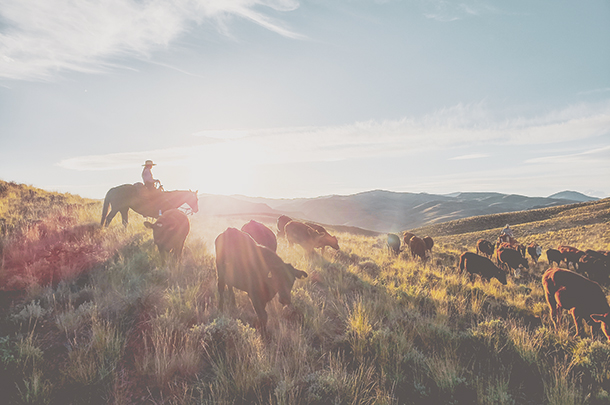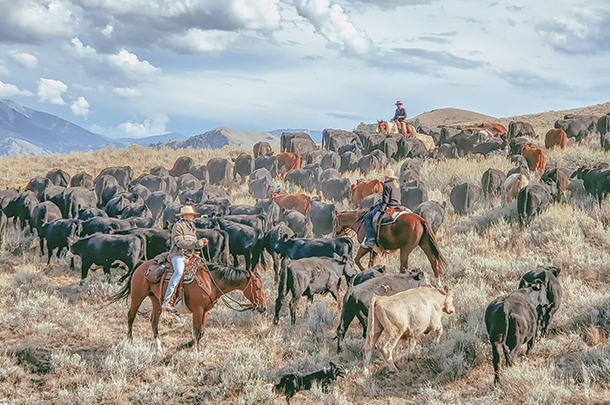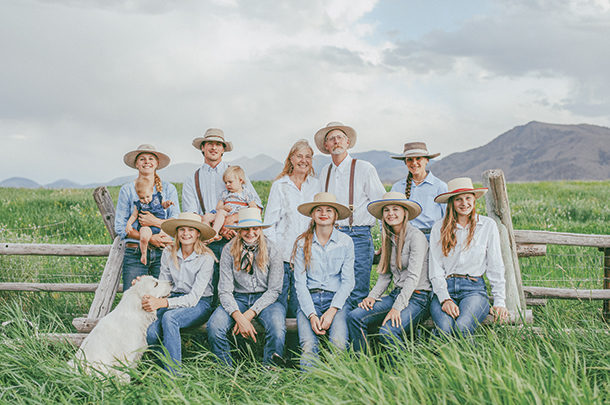However, as many ranching families know, it’s not always as simple as it sounds.
Glenn and Caryl Elzinga of Alderspring Ranch in May, Idaho, were no strangers to the risks of ranching in the frontiers of the West.
2014 was one of those years that left their family asking the “what now?” question. Forced with the reality of leaving behind their rangelands in the breathtaking Salmon River Mountains due to wolf predation, the Elzingas spent the winter months feeding cattle and questioning how to move forward. Over the summer months, the ranch had lost 14 head of cattle on the permits during a time when cattle prices were quite favorable. Glenn noted that turning out again felt like “economic suicide” they simply couldn’t afford.
With seven daughters, Glenn and Caryl not only wanted to make ranching economical, they wanted to make it sustainable for the future generation.

Canine predation aside, the Elzingas were not blind to the fact their cattle didn’t do well on the range; time management wasn’t efficient when trying to gather or move cattle across the 46,000 acres of pastures, gains were low, and forage was either being under- or overgrazed.
While wolves were the straw attempting to break the camel’s back, the challenge of how to recover the next year loomed over the Elzinga family. However, hidden in a Charlie Russell painting in his neighbor’s living room, Glenn found the answer.
While staring at the painting one December evening, Glenn noticed the cowboys in the painting were living with their cattle. They were living with the herd to protect them and to find the best feed.
Thus, the art of herding was reintroduced to the range by Alderspring Ranch through “inherding.”

With experience in high-intensive grazing and holistic management on their home pastures, Alderspring Ranch decided to experiment with that concept on the treacherous and diverse landscape available to them on their permits. “We’re translating the concept of high-intensive grazing to a larger landscape,” says Caryl. “Instead of hot wire, we’re using people on horseback.”
Now, rather than opening a gate and wishing their cattle the best of luck on the mountains, Alderspring Ranch lives with their cattle all summer long.
Previously, cattle would spend their summers “scattered to the four winds,” and the Elzingas would spend anywhere from one to three days each week on horseback trying to locate cattle and move them off riparian areas. “I’m not against using riparian areas, but I saw the need to give ours a rest,” noted Glenn.
Cattle were gaining approximately 1/2 pound per day on the range and coming back to the home ranch with lower body scores than Glenn felt acceptable. “It [the range] was more of a place for us to stick cattle out of our way so we could focus on finishing cattle at home and making hay,” he says, “but we would spend all fall trying to play catch up on those low body scores [coming off the range] before winter hit.”
Now Alderspring Ranch has their cattle in their pocket all summer long. Instead of opening gates and chasing cattle for an entire month at the end of the season, the Elzingas send their crew of up to four people on horseback to live with the cattle in shifts of four to five days. During the months of May to September, the cattle are never alone and are herded to the best forage on the rangeland.
“Our destination is a plant,” says Glenn. “We’re herding them while they eat so their heads are down and their bellies are full.”
Though pictures from Alderspring Ranch look peaceful, life on the range can take after some of the wilder Charlie Russell depictions. “There is an art to herding animals that maximizes gain,” says Glenn. From the occasional runaway horse, employees burning out and uncooperative cattle, life on the range is not an extended trail ride. “Keeping morale at a level of integrity is a huge part,” Glenn reflected, “the first few years were kind of a debacle.”
However, by partnering with the Nature Conservancy in their area, the Alderspring Ranch was able to offset employee cost in the first few years to help them troubleshoot the best ways to keep cattle and people happy. “After five years, we’ve got our legs under us,” Glenn says.
Melanie Elzinga, the eldest of seven daughters, uses the time to focus on her passion for natural horsemanship and stockmanship. “It is a great way to put miles on a horse,” she says, “and I’ve really grown to love stockmanship. The partnership between human and animal is really fulfilling to see.”
The family knows ideals can’t keep an operation in the black, and with economic strain being a driving force behind the inception of this practice, it needed to pencil. “Our goal was to make this [inherding] come out, cost wise, to be equal to running on private ground,” says Caryl, noting that running on private, leased pastures was their “next best” alternative to turning out on the range.
Gains shown coming off the range have directly impacted returns for the Alderspring Ranch despite being limited by the topography of the landscape. “We have cattle gaining up to a pound and a half up there now,” says Glenn. With eyes on the future, Melanie Elzinga hopes the family can explore their newfound practices on larger allotments with a larger herd where the landscape is more forgiving. “We are limited by the severity of the landscape,” she says. “We would love to implement inherding on new allotments with larger valleys and bigger country.”
Despite those topographical limitations, intentionally placing cattle on forage has been closely monitored by Caryl, who holds a Ph.D. in plant ecology, and the gains shown in plant life and riparian health are without comparison in most rangeland settings.
With steep elevation climbs, forages on the range can vary greatly from high-elevation lodgepole forests to salt-desert scrubs. “Plant communities are quite different from bottom to top,” says Caryl, “and now we are able to choose forage for them [the cattle].”
Resurgences of natural aspen stands, healthy forages and native (non-invasive) species, the practice of inherding is adding value to both cattle and land at the same time. This powerful, and eye-appealing, testimony to land stewardship often sets Alderspring Ranch apart from others in the saturated niche beef market. “They are more than grass-fed or certified organic cattle,” says Melanie, “they are regenerating the land.”
Despite growing pains and the upheavals that got them here, Alderspring Ranch can truly proclaim they are one family on one ranch. “There are a lot of people who are really sad in agriculture today, but there is amazing hope for my kids,” says Glenn.
With business booming in direct-to-consumer sales due to the health crisis facing the world, Alderspring Ranch finds itself in a hopeful place many ranches long for. The trickle-down effect being felt from the decision to bring a Charlie Russell painting to life is as refreshing as fresh snowfall on the high reaches of mountain range towering above the lush valley of Idaho, where the Elzinga family still calls their home. ![]()
PHOTO 1: The Elzinga family believes the diversity on their ranch allows for each of their seven daughters to have a unique place on the operation in the future.
PHOTO 2: Utilizing targeted grazing has allowed Alderspring Ranch to keep cattle in good body condition while on summer permits while resting riparian areas.
PHOTO 3: Alderspring Ranch in May, Idaho, has taken the range back into their hands by incorporating intensive grazing practices on their mountain permits. Photos by Melanie Elzinga.
Lydia Kyle is a freelance writer based in New Mexico.











